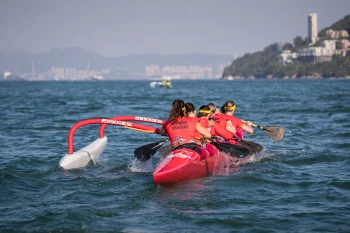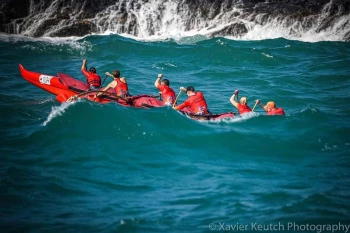Outrigger Technique
Did you think training stops when you get out of the water? Ha! Watch our favorite YouTube videos below and absorb the knowledge.
OC Stroke Technique
With your stroke, your goal is to move the boat forward, not move the water backward. Water does not like to be pushed against. Have you ever pushed water with your hands? It gets out of the way. Your paddle has the same problem. When you plant your blade in the water and puuuuull with all your might, the water will just slide to the side and you, my friend, are going nowhere.
So how do you get around this slippery issue? First, make sure when you plant your blade, it is fully submerged in the water. All the way. Your paddle is flat for a reason and that reason is to push water, not air. If your blade isn't fully submerged in the water you are moving air.
How do you know you are moving air?
One is your stroke is noisy and splashy. Noise and splash are created when your paddle slaps the water, mixing in air. A silent paddle is a powerful one.
Two you are moving too fast! Counter-intuitive I know. But when you paddle fast you are drawing air into the water. This makes it easier for the water to slip to the sides. Even if you bury your blade silently, if you move too quickly you draw in air and create little whirlpools, reducing your power.
Do not move air. Air is light and you cannot apply the power of your blade to air. Your job is to move water.
How do you move water?
One enter the water silently, with as little splash as possible. This ensures your catch will only contain water.
Two wait a split second for the water to wrap around your blade. Then pull. Pull slowly. Pull gradually, accelerating your blade. This will create a catch. You will know it when you feel it. It will feel like you are pulling against quicksand. Like the ocean is fighting against you.
The weight comes from the principal of propulsion: it is better to push a large mass slowly (i.e. the ocean) than a small mass quickly (i.e. air + water).
Strive for a slow, heavy paddle and you will master the catch. Master a catch and your canoe will fly.
The stroke
There are a six parts to an efficient stroke.
Reach
Catch
Pull
Exit
Recovery
Reach
When you reach, your upper arm should be just slightly above your head, your lower arm should be fully extended. Try to reach as far as you can and plant you blade fully in the water.
Catch
Slowly. SLOWLY accelerate your paddle downward. You should feel resistance. It should feel hard. If you don't, you're pushing air and you are wasting strength.
Pull
As you push the paddle down keep your arms relatively straight and rigid using your back, your legs, and your core. Do NOT pull with your biceps. Your arms are the weakest part of your body and if you are pulling with your biceps you are not going to last a 20-40k race.
Keep the blade parallel to the boat, don't bend your top wrist and plunge down as straight as possible. If you are not parallel, your paddle is going to propel the canoe sideways, making the steer's life harder. You do not want to anger the steer.
Exit
Once the blade / lower arm reaches your hips your stroke is over. There is no more power to be gained. So lift your paddle out of the water gracefully, parallel to the boat with as little splash as possible.
Recovery
Notice this is called "Recovery" not "Rest". Reset your body to do the next reach. This should be quick. For a casual paddle your blade should be in the water twice as long as your recovery. If you are in a race, your recovery should be quicker. Race pace is long in the water, fast recovery.
For visual learners here are some videos
Video Analysis of Technique
Coach Lee's Notes: Watch the slow rating, the depth and set of the blade. The weight behind the catch while still being slow in water.
There's a slight flare on the recovery, almost skimming the water without touching. Natural float. Hinge from the waist and float forward. The stoke is gripping and holding the water, not pulling but feeling resistance.


